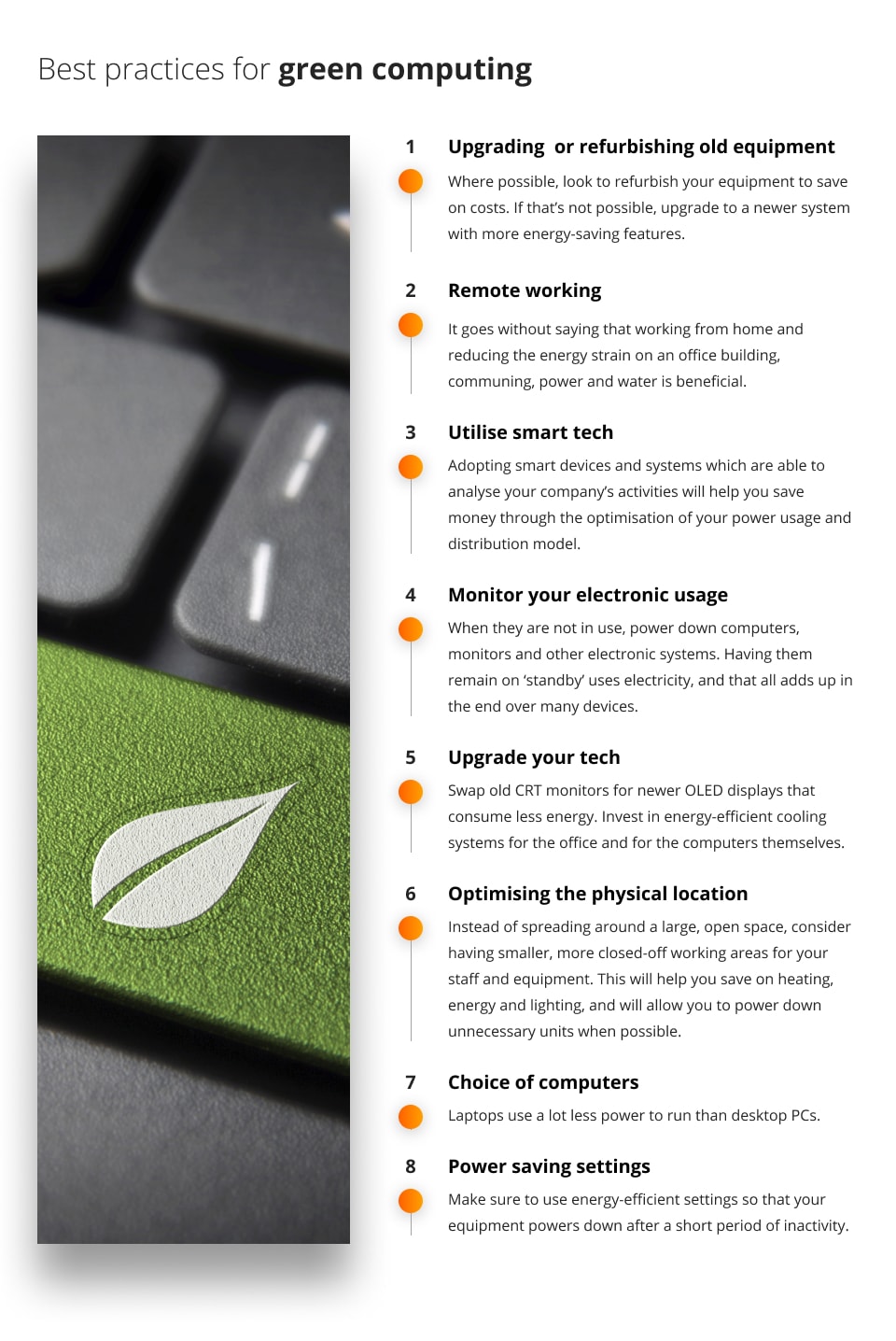
Green Computing: benefits, importance and the future of Green IT
Green computing is known by several different names: green technology, green IT and environmentally friendly computing are some of the most common variations.
What is green computing?
Green computing refers to using computers, electronic devices and computing equipment in an energy-efficient manner. It is all about the design, green manufacturing, energy efficient computers, and disposal of these devices in a way that helps to reduce unnecessary environmental impact by manufacturers, data centers, and even end-users.
Green computing is also concerned with selecting sustainably sourced renewable materials that reduce electronic waste and prompt sustainability across the IT industry.
The energy demands, and carbon output of computing and the entire ICT sector must be dramatically moderated if climate change is to be slowed in time to avoid catastrophic environmental damage.
Association for Computing Machinery
Why is Green Computing important?
Energy-efficient computing has the potential to make a huge impact on our environment and sustainable software. In these troubling times of excessive waste, pollution and carbon emissions, we must look to technology as a means of positively impacting our world.
A 2021 report from the Technology Policy Council on Computing and Climate Change estimated that between 1.8-3.9% of all global carbon emissions can be attributed to the IT sector. They state that data centres use 3% of all energy consumed worldwide and that these data centers have doubled their energy consumption rates over the past ten years alone.
Every single piece of modern technology has a carbon footprint. It takes time designing it, manufacturing it, testing it… There is a ‘carbon price tag’ for all components, from a huge data center right down to the smallest chip. Green and friendly computing is a process that seeks to reduce these carbon price tags.
Technology companies are driving the green revolution along with large corporations, governmental bodies and charities. GreenTech can be adopted by any large-scale user of technology, who can have a massive impact by taking on board the green computing model.
Green computing strategy: how your tech habits impact the planet
Computers and related devices consume significant energy, often from non-renewable sources, leading to greenhouse gas emissions. They also contain harmful materials, posing pollution risks if not disposed of properly.
Green computing practices reduce these negative impacts, promoting sustainability and cost-effectiveness. By decreasing energy usage, resource consumption and minimising waste, it makes our tech habits more eco-friendly, steering us towards a more sustainable technological future.

How sustainable computing can help you be more energy efficient?
We live in uncertain times where the cost of living has gone through the roof. Heating, electricity and gasoline have all shot up in price, as have utilities. It’s important now more than ever to look at cost-saving measures for our businesses and homes.
All electronic components associated with computers and computer systems use energy. From PCs, power systems, HVAC and lighting systems right through to your climate control unit, everything requires energy to function. Green computing can make a huge difference when it comes to saving money on electricity and reducing energy consumption.
Following the sustainable computing ethos of using energy-saving processes when designing and manufacturing systems throughout their life cycles enables us to make a big difference. These small but consistent improvements across the board help to drive energy efficiency in a big way once they all add up.
Every single component saves just a little bit of energy when in use, runs a tiny bit quicker, is slightly more efficient to produce, and can be recycled or reused more easily – this is the philosophy of green IT.
Other benefits and advantages of green computing
Green computing has more benefits than just saving energy and protecting the environment. It also helps to make products that last longer and use less energy, which means we don’t have to replace them as often. This saves energy, materials and it’s environmentally responsible. Plus, it’s cheaper to maintain and use fewer resources in the long run, which means lower costs of computing devices.
In addition to encouraging innovation, this strategy pushes for the creation of new, more efficient softwares, which can have positive effects on green design. By being green with their computing practices, businesses can boost their public perception, which in turn helps them reach their CSR objectives, establish code of ethics and draws in eco-conscious consumers.
Moreover, green computing not only reduces power usage and GHG emissions but also contributes to the global effort to combat climate change. This is in line with international environmental standards and helps create a better world for future generations.
10 ways to apply green computing
Are you thinking about how to be more eco-friendly? Many companies now look to green computing as part of their digital transformation strategy. Optimising the software and hardware of your systems is a great way to save money and work more efficiently.

The benefits of adopting a green computing strategy are clear. You will save money on your utility bills, your operations will be more efficient, and you will fully utilise all equipment. Environmentally friendly computing is not exclusively reserved for large corporations and data centers servicing millions of people.
It begins on the individual level with every single one of us.
Here are some useful tips that each and every person could implement into their lives in order to adopt a green computing mindset.
Repairing and reusing equipment – It is always significantly more expensive to create something new than it is to fix something old. The design and manufacturing process alone is extensive. Even if your equipment doesn’t meet your needs, as long as there’s still the possibility of repair, donate it to a person or organisation that might make use of it.
Make a conscious effort to purchase refurbished equipment – Supply and demand are key: If more people are happy to buy refurbished equipment, then more and more equipment will be renovated. It is cheaper than buying a brand new product, and they often come with warranties that guarantee you it’s a good quality, functioning product.
Use power-saving modes and power management features – Reducing your screen’s brightness, choosing electronic equipment with energy star label, setting it to power down after just a few minutes of inactivity are all great ways to go green.
Use energy-efficient hardware: Consider opting for energy-efficient hardware options, such as multicore processors and high-efficiency power supplies.
Switch to cloud computing: Migrating to cloud storage and computing can have a positive impact on your environmental sustainability by leveraging scalable resources and minimising the need for physical infrastructure.
Store data locally: Opt for networks that store data locally to save energy, which is especially beneficial for companies operating globally.
Create digital twins for efficiency: Make the most of digital twins to find and fix inefficiencies, which will reduce waste and improve production processes.
Analyse and update application performance: It is important to regularly analyse and update your software applications to ensure they are efficient. This will help avoid resource wastage caused by outdated or inefficient software.
Adopt edge computing: Edge computing is a technology that processes data closer to where it is generated. It is an effective way to decrease energy consumption and improve efficiency, particularly in network usage.
Implement virtual machines: Use virtual machines on servers to reduce the number of physical machines needed. This approach lowers energy use and carbon emissions by optimising server capacity and minimising operational power requirements.
These common methods are easy to implement, but they make a huge difference both on an individual and societal level. Who wouldn’t want to save money on their energy bills by adopting a green strategy?
What future trends in environmentally friendly computing should you be aware of?
The field of green computing is expected to progress in reducing technology’s carbon footprint.
This will involve developing more eco-friendly manufacturing processes for hardware and a greater focus on the entire lifecycle of devices. Innovations in chip design are anticipated to improve efficiency and reduce emissions.
As cloud computing continues to expand, there will be efforts to make data centres more energy-efficient and achieve green computing.
Read more about ESG and environmentally sustainable solutions:
What is green coding? A contribution to save the environment
Drive to sustain: exploring the intersection of Formula 1 and sustainable business strategies
Why (and when) should businesses consider switching to Green IT?
Businesses should think about switching to energy efficient devices now, as it’s not just good for the planet but also smart for their bottom line.
With the growing emphasis on sustainability, going green can reduce energy consumption enhance brand reputation, and keep you ahead in an increasingly eco-conscious market. Plus, it preps you for stricter environmental regulations down the line.
And here’s a great part: partnering with firms like Future Processing can help you make this shift more effectively, tapping into the latest innovations that maximise efficiency and minimise your ecological footprint.



